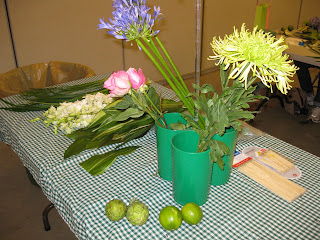Dishing it out….
Last Friday at the Berkshire
Botanical Garden (www.berkshirebotanical.org), I taught a class called “Cutting
Edge Design: Not your mother’s flower arrangements”. We began with a brief power point on the exciting new
arrangements that take on the aspect of organic sculptures. Then we got down to the business of
making a two-dish design.
The students used these wonderful glass
plates with cobalt blue swirls (www.target.com & only online) in two
sizes, dinner and salad. These
very reasonable plates come from Murano, the glass making island near
Venice.
Using two pieces of Oasis,
we set them up with an oasis between the dinner and the salad, and one on top
of the salad. A quarter slice of
oasis went between each plate, the edge covered by part of an aspidistra leaf. These are variegated leaves with random white striping.
The other materials were: white mini calla lilies, sky blue
agapanthus, bright pink roses, lime green spider mums, variegated
aspidistra, lily grass, galax leaves, bear grass, baby artichokes and small
limes.
The students did a great
job! Once they had assembled their plates - rather like making a floral an ice cream sandwich - they then chose where they wanted to put the fruits. Limes and artichokes were left whole in some places and sliced in half in others.
Despite the fact that they all used the same materials, each design had an individual flair. Rhythm is created by the
linking of the two levels of the design.
Assorted glass headed corsage pins
(www. jamaligarden.com) help to hold some of the plant material in
place.
Using the
bear and lily grasses, the levels can be linked and the design gains some exuberance from these large spaces which are created.
Any shape plate can be used
as I did here with square plates, putting one on the diagonal to the other. Glass plates with an
interesting edge (see demonstration of oasis above, plates from Crate & Barrel) sets up a cool summery water-like aspect
to the design. The artichokes which have
the look of water lily buds carry that idea through.
Always use two skewers
parallel to each other to hold the fruit into the oasis. Oil of clove (health food, drug
stores) on the skewer will create a seal and eliminate the opening as a source
of fruit flies – but cannot promise the same for the surface of a cut lime.
The design above was done several years ago in East Hampton. These plates are much larger and you can see I have used much more material including some white and green tulips and moss. No rules to this idea, its fun and sturdy! To keep the oasis moist put some ice cubes between the flowers and let them melt down.
Cheers!










Absolutely wonderful!Thanks, Susan.
ReplyDeleteA class called “Cutting Edge Design: Not your mother’s flower arrangements” - But what if it IS your mother's arrangement?! :-)
ReplyDelete